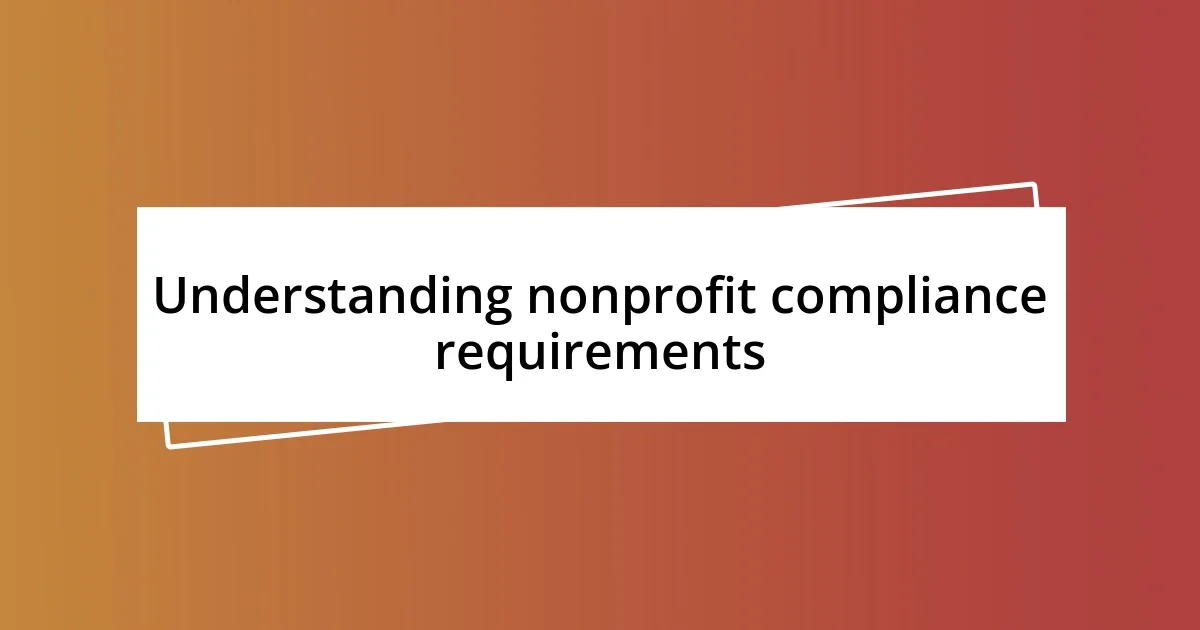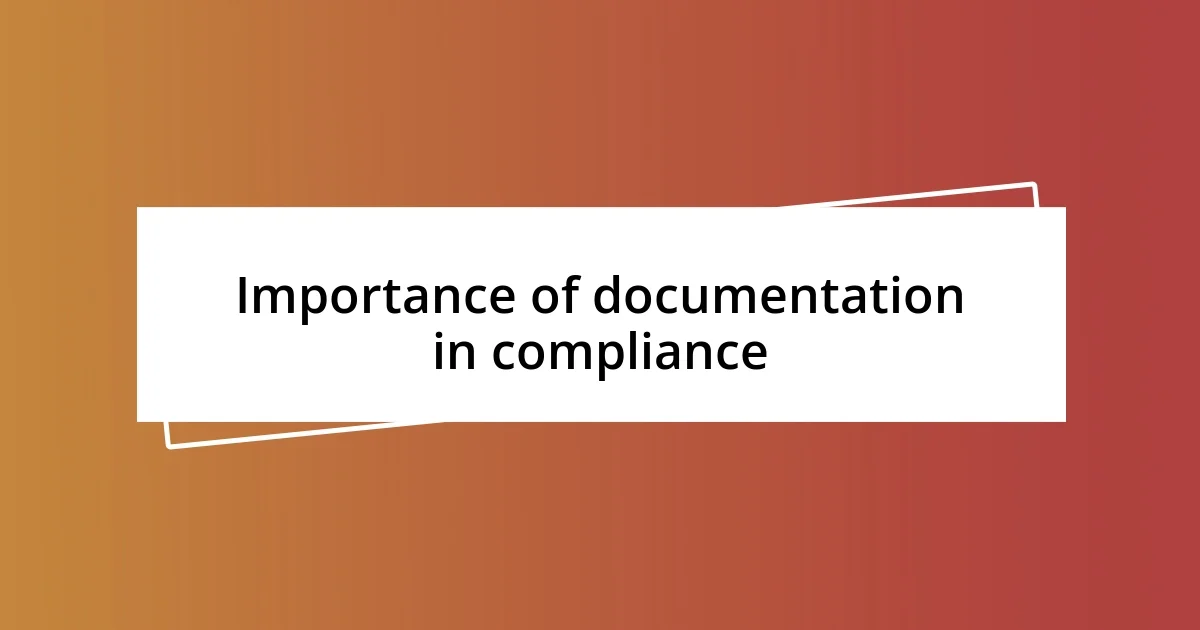Key takeaways:
- Understanding and managing nonprofit compliance fosters trust with stakeholders and enhances organizational integrity.
- Implementing proactive strategies, such as compliance calendars and regular training, alleviates stress and promotes a culture of accountability.
- Documenting processes and monitoring regulatory changes are crucial for effective compliance management and continuous improvement within nonprofits.

Understanding nonprofit compliance requirements
Understanding nonprofit compliance requirements can often feel overwhelming, especially for someone just stepping into the nonprofit world like I was not long ago. I remember my first encounter with the myriad of regulations—each seemed more complex than the last. Can you imagine sifting through mountains of paperwork while trying to stay focused on your mission?
As I delved deeper, I discovered that compliance isn’t just about following rules; it’s about building trust with your community and stakeholders. Once, I forgot to file a crucial report on time, and it was a stark reminder of the consequences. Everyone relied on me, and suddenly, I felt the weight of accountability. Isn’t it crucial to realize that each compliance step you take contributes to the organization’s integrity?
In my experience, staying informed about your specific compliance requirements—like state regulations, IRS guidelines, and local laws—empowers you to do the work you love without fear. I began attending workshops and webinars, transforming compliance from a drudgery into a topic I could embrace. What resources have helped you navigate your compliance journey? It’s fascinating how knowledge can turn anxiety into confidence.

Common challenges in nonprofit compliance
Navigating nonprofit compliance is like trying to find your way through a labyrinth. One common challenge is keeping track of diverse funding requirements. I remember tackling multiple grants at once, each with its unique set of compliance criteria. The pressure was intense, and it felt like I was juggling flaming torches—one wrong move, and everything could go up in smoke. Does anyone else feel that thrill mixed with anxiety when deadlines loom?
Another significant hurdle is the constant shifting of regulations. I often felt like I was on a never-ending roller coaster—just when I thought I had a grasp on the rules, something changed. This is especially true for tax laws, which can be a maze of confusing language and intricate details. It’s as if the goalposts keep moving, and you have to stay agile to keep up. Have you experienced that sense of uncertainty lingering overhead?
Finally, there’s the challenge of ensuring that all board members are on the same page regarding compliance. From personal experience, I found it was crucial to cultivate an environment of open communication. I once faced a scenario where a board member was unaware of a significant compliance issue, which almost resulted in an embarrassing situation for our organization. Creating a culture of compliance isn’t just beneficial—it’s essential for the survival of the nonprofit.
| Challenge | Description |
|---|---|
| Diverse Funding Requirements | Managing various grants with specific criteria can feel overwhelming and leads to missed deadlines. |
| Shifting Regulations | Constantly changing rules, especially in tax laws, create a sense of confusion and uncertainty. |
| Board Member Awareness | Ensuring all board members are well-informed is crucial to avoid compliance mishaps. |

Strategies for effective compliance management
Establishing effective strategies for compliance management is essential for smooth sailing in the nonprofit sector. I learned early on that proactive measures can make a world of difference. For instance, I vividly recall the first time I created a compliance calendar. It felt like organizing my cluttered workspace—suddenly, everything was clear and manageable. By mapping out key deadlines and tasks, I found I could focus more on our mission rather than juggling due dates.
Here are some strategies that have worked for me:
- Implement a Compliance Calendar: This tool served as my go-to for tracking crucial deadlines and requirements.
- Create an Accountability Framework: Designate compliance roles within your team, ensuring everyone knows their responsibilities.
- Regular Training Sessions: I found that frequent training helped keep compliance fresh in everyone’s minds, turning our team into a well-informed unit.
- Utilize Technology: I turned to software that assists with compliance tracking, which has been a lifesaver in managing documentation and regulatory updates.
- Foster Open Communication: It’s essential to create an environment where team members feel comfortable asking questions about compliance. This approach not only clarifies doubts but also cultivates a culture of inclusivity.
By following these strategies, I saw a significant reduction in compliance-related stress—transforming what used to feel like an uphill battle into a manageable part of our routine. It’s all about turning compliance into a collaborative journey rather than a solitary chore.

Importance of documentation in compliance
Documentation is the backbone of nonprofit compliance. During my first few years working in this field, I learned that keeping meticulous records could save my organization from potential crises. I remember a time when we faced an audit after a grant application misstep. Thanks to our organized documentation, we managed to present everything flawlessly, avoiding fines that could have crippled our resources. Can you imagine the relief when we realized that a small detail, carefully documented, made all the difference?
The process of documenting compliance also fosters accountability within the team. I’ve experienced how clear and accessible documentation encourages team members to take ownership of their roles. For example, I once set up a shared drive where everyone could upload their compliance-related materials. This transparency cultivated a sense of responsibility, and team members felt more engaged in our mission. Doesn’t it make you wonder how much more effective your team could be with the right documentation systems in place?
Lastly, documentation isn’t just a safeguard—it’s a tool for improvement. Reflecting on our processes through documented feedback helped us identify gaps and areas for enhancement. I recall a brainstorming session stemming from a compliance review that sparked innovative solutions we hadn’t considered before. How often do we overlook the power of reviewing our own records to shape our future? In the world of compliance, I’ve found that treating documentation as a living, breathing entity can lead to continuous growth and a stronger foundation for our nonprofit.

Monitoring changes in compliance regulations
Monitoring changes in compliance regulations can feel overwhelming, but it’s crucial for keeping your nonprofit on track. I recall a particular moment when a new law affecting charitable donations was announced. I was initially anxious, but I quickly realized how vital it was to stay informed. Setting up alerts and subscribing to newsletters made me feel much more in control, and I could directly see how proactive monitoring influenced our decision-making.
It’s not just about the updates; it’s about understanding how these changes impact your organization. I remember sitting in a meeting when the importance of compliance updates became clear. One missed regulation could lead to severe consequences, and it hit me how every tiny detail matters. Engaging with peers and attending workshops helped deepen my understanding and provided a space to discuss regulatory nuances, igniting a spark of community among our nonprofit colleagues.
I often find myself reflecting on the relationships your organization builds through compliance discussions. By reaching out to regulatory bodies and joining forums, I’ve learned that collaboration allows for shared knowledge. Have you considered how building these connections could enhance your compliance efforts? Through candid conversations with other nonprofit leaders, I became aware of pitfalls to avoid and best practices to adopt, enriching my experience and ultimately benefiting my organization.

Best practices for compliance training
In my experience, the most effective compliance training doesn’t just focus on the “what” and “how,” but rather the “why.” I recall conducting a training session that opened with a real-life story of a nonprofit facing legal consequences due to compliance failures. It was fascinating to see how sharing this narrative shifted the atmosphere; suddenly, everyone understood the stakes and felt a personal connection to the training materials. Don’t you think that when people grasp the importance behind compliance, their engagement naturally skyrockets?
Interactive training methods can also make a world of difference. During one particular workshop, we incorporated role-playing scenarios that put team members in the shoes of compliance officers dealing with potential violations. The energy in the room was palpable as we navigated challenges together. I found that participants retained information better when they acted it out. Have you ever noticed how hands-on experiences often leave a lasting impression?
Lastly, I believe ongoing support and resources after training are paramount. I introduced a quarterly Q&A session where team members could bring their compliance-related questions and share experiences. This ongoing dialogue not only reinforced learning but also nurtured a culture of open communication. Each time we met, it felt more like a support group than a formal review, fostering trust and collaboration. Isn’t it amazing how a simple setup can transform the landscape of compliance within an organization?

Case studies of successful compliance efforts
One of the most compelling case studies I encountered involved a small nonprofit that dramatically turned its compliance issues around. They faced hefty fines due to inconsistent reporting practices. Instead of seeing those fines as a dead end, the leadership decided to transform their approach. I watched them implement a dedicated compliance officer role, which made all the difference. The energy in their office changed—everyone felt more empowered knowing there was someone to guide them through the complexities of regulations.
Another great example comes from a large charity that successfully navigated a major compliance overhaul after a federal law change. They organized a comprehensive team retreat focused solely on compliance strategy, fostering a sense of unity among staff. The result? Not only did they meet compliance standards ahead of the deadline, but the team felt more connected and engaged with their mission. Reflecting on this, I wonder: can a well-planned retreat positively impact compliance beyond mere legal obligations?
A nonprofit I worked with took a unique approach by leveraging technology to enhance their compliance efforts. They introduced a cloud-based management system that streamlined document tracking and reporting processes. During one presentation, the team leaders shared how this initiative saved them countless hours and headaches. I was genuinely surprised by how technology could be a game-changer in promoting succinct compliance. Have you considered how innovative tools might simplify your own compliance journey?














